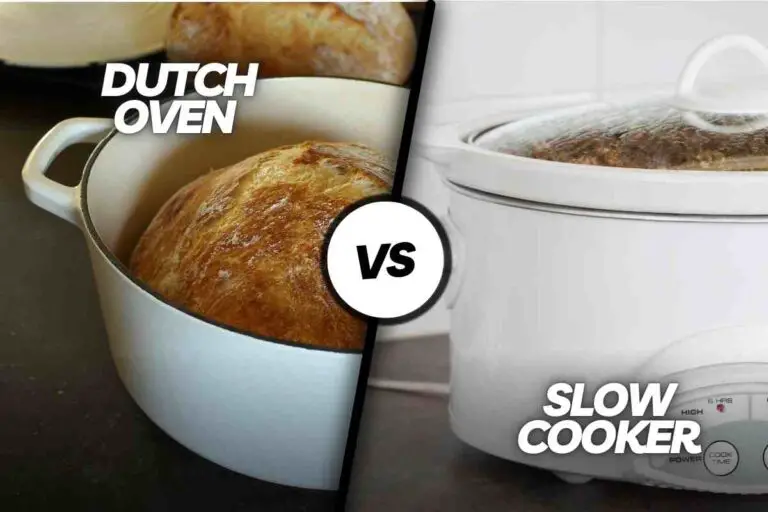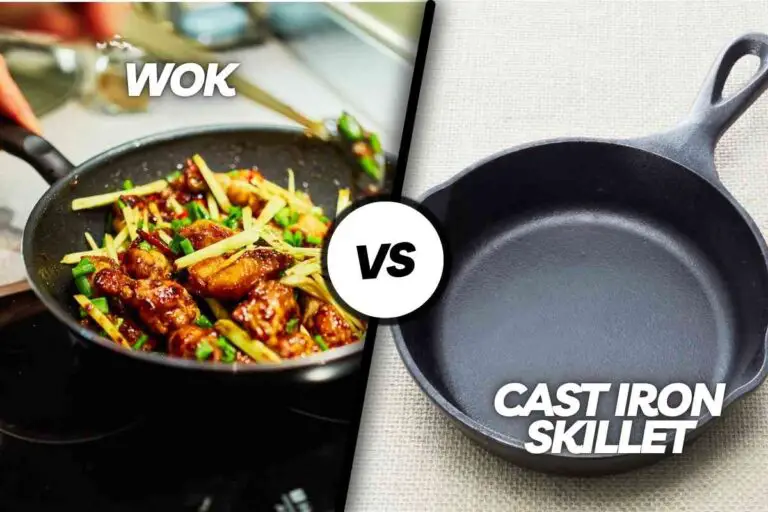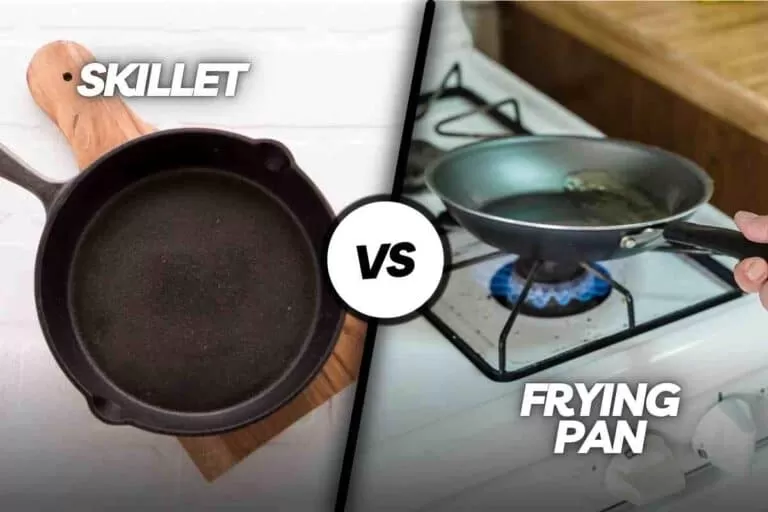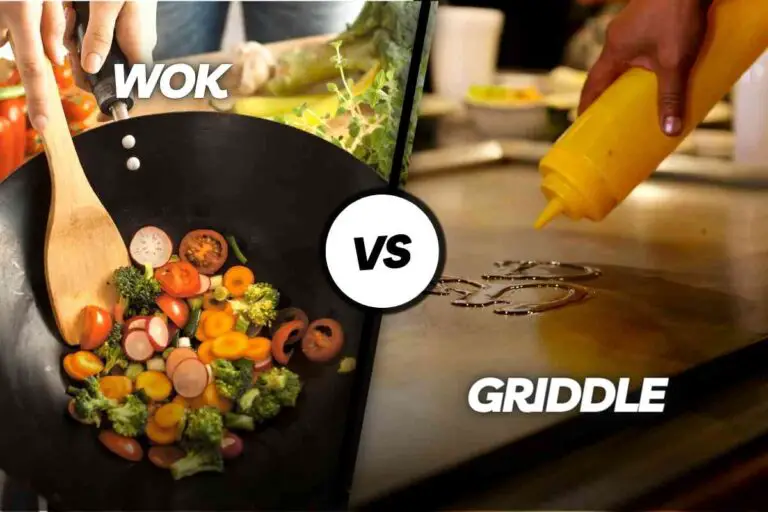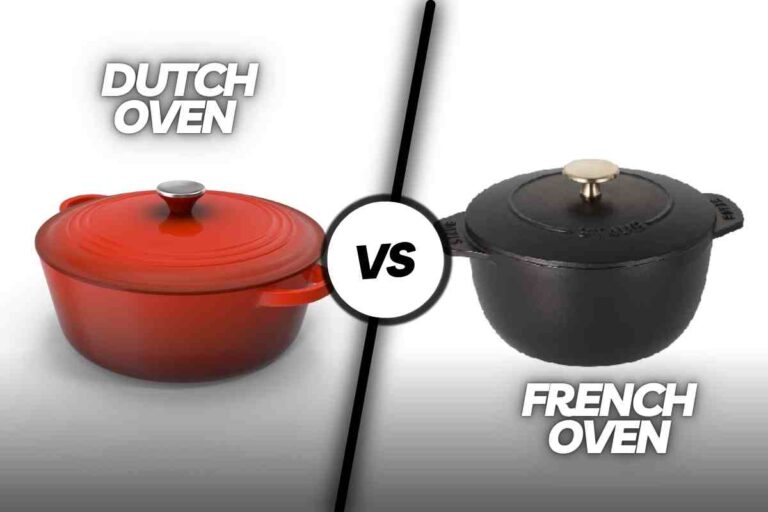What Is Difference Between Radiant And Induction Cooktops?
The main difference between Radiant and Induction Cooktops is the method of heat generation. Radiant cooktops produce heat by passing electricity through heating elements, which then emit heat waves to warm cookware. While, Induction cooktops use copper coils to create an electromagnetic field, heating cookware through magnetic induction, akin to a microwave’s heating process.
Induction cooktops are more energy efficient than radiant ones and offer the same cooking performance. They can be cleaned with mild detergents and a ceramic cleaning paste.
Radiant cooktops tend to be cheaper than inductive models, but heat loss makes them less efficient.
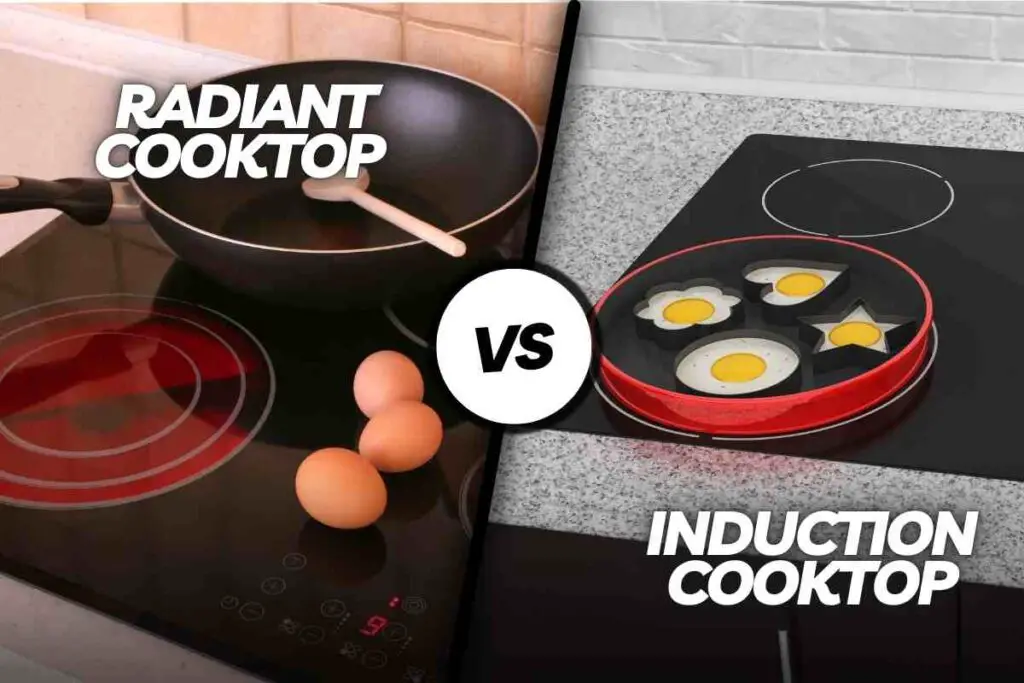
Radiant vs Induction Cooktops Quick Summary
| Aspect | Radiant Cooktops | Induction Cooktops |
|---|---|---|
| Heat Source | Electric heating elements beneath glass | Electromagnetic field directly in cookware |
| Cookware Compatibility | Glass, copper, aluminum, and more | Iron or steel with a smooth, flat bottom |
| Temperature Control | Limited fine control, slower response | Instant and precise temperature adjustments |
| Energy Efficiency | Less efficient due to heat transfer | Highly efficient with minimal energy loss |
| Cooking Speed | Slower to heat up and cool down | Rapid heating and cooling |
| Safety | Surface remains hot even after turned off | Surface is safe to touch after cookware is removed |
| Cleaning | Smooth surface, easy to clean | Smooth surface, easy to clean |
| Cost | Generally less expensive | Tends to be more expensive |
| Operating Costs | May be higher due to energy inefficiency | Generally lower due to energy efficiency |
| Compatibility with Cookware | More versatile | Requires specific |
What Is an Induction Cooktop?
An induction cooktop is an alternative to conventional stovetops. This type of cooking appliance uses an electromagnetic field to generate heat directly inside the cookware. As a result, induction cooktops run cooler.
The electromagnetic field alternates as an electrical current to heat the cookware. The heat is then transferred from the cookware to the food. This method ensures that food is cooked evenly and that heat energy is not wasted.
Induction cooktops have some drawbacks, such as the fact that you can’t see which burner is heating.
As a result, you can’t tell if your pan is too hot or not. Another disadvantage is that induction cooktops tend to hum. The hum will become louder as the temperature rises.
The magnetic field from induction cooktops will heat a ferrous metal, such as cast iron. However, you can’t use copper or aluminum, as these metals don’t produce enough resistance to produce heat.
Also, you can’t use non-ferrous cookware with an induction cooker, such as glass or ceramic.
It’s best to check to see if the cookware you’re considering buying is induction compatible before investing in a new one.
What Is a Radiant Cooktop?
A radiant cooktop is a type of stovetop that uses radiant heat to cook food. Radiant heat is a type of energy that travels in waves and is absorbed by surfaces with which it comes into contact.
When radiant heat waves come into contact with a pot or pan on a radiant cooktop, they are absorbed by the pot or pan and then transferred to the food that is being cooked.
Radiant cooktops are becoming increasingly popular because they are very efficient at cooking food. They also tend to be very easy to clean because there are no burner grates or other parts that can get dirty.
One downside of radiant cooktops is that they can be more expensive than other stovetops. They also require unique pots and pans made of materials that can absorb radiant heat.
Is Radiant and Induction the Same?
Induction vs radiant cooktop: No, radiant and induction are not the same. Radiant cooktops use heating elements beneath the glass surface to transfer heat to the cookware. Induction cooktops work by generating a magnetic field that creates heat directly in the cookware, rather than in the heating element.
Difference Between Induction and Radiant Cooktop
So, what is the difference between radiant and induction cooktop?
Radiant vs induction cooktops: When choosing a cooktop, it’s important to weigh the features and benefits of each. Induction cooktops are safer, and their top surfaces remain cool while cooking.
Heat Source
Electric heating elements beneath glass
Electric cooktops with heating elements beneath a glass surface generate heat through resistance.
When you turn on a heating element, it produces heat, which is then transferred to the cookware on top of the glass surface.
The glass itself does not heat up but serves as a protective and insulating layer.
Electromagnetic field directly in cookware
Induction cooktops use electromagnetic fields to directly heat the cookware.
When you place compatible iron or steel cookware with a smooth, flat bottom on the cooktop, the electromagnetic field induces currents in the cookware, generating heat.
The cookware itself becomes the source of heat, and no external heating elements are involved.
Cookware Compatibility
Glass, copper, aluminum, and more
Electric cooktops with glass surfaces can be used with a wide range of cookware materials, including glass, copper, aluminum, and various other materials.
They do not require specific cookware types but may perform better with those that have flat bottoms for better heat transfer.
Iron or steel with a smooth, flat bottom
Induction cooktops are compatible only with cookware that contains iron or steel and has a smooth, flat bottom.
The cookware must also have a magnetic property to work with the induction process. Non-compatible cookware materials include aluminum, copper, and glass.
Temperature Control
Limited fine control, slower response
Electric cooktops typically offer less precise temperature control compared to induction cooktops.
They may have a lag in temperature adjustment, making it challenging to achieve precise cooking temperatures quickly.
Instant and precise temperature adjustments
Induction cooktops excel in temperature control. They can instantly and precisely adjust the cooking temperature, offering fine control.
This makes them suitable for tasks that require precise temperature management, such as simmering or searing.
Energy Efficiency:
Less efficient due to heat transfer
Electric cooktops are less energy-efficient because they rely on the transfer of heat from the heating element to the cookware.
Some heat is lost during this transfer, making them less efficient in terms of energy consumption.
Highly efficient with minimal energy loss
Induction cooktops are highly efficient because they heat the cookware directly through electromagnetic fields.
There is minimal energy loss, as the heat is generated within the cookware, resulting in efficient energy use.
Cooking Speed
Slower to heat up and cool down
Electric cooktops are slower to heat up and cool down compared to induction cooktops.
The heating elements take time to reach the desired temperature and also retain heat for a while after being turned off.
Rapid heating and cooling
Induction cooktops heat up cookware almost instantly and cool down quickly when turned off. This rapid response allows for more precise cooking and reduces the risk of overcooking or burning.
Safety
Surface remains hot even after turned off
After turning off an electric cooktop, the glass surface can remain hot for a significant period. This poses a burn hazard, especially if accidentally touched or if items are left on the cooktop.
Surface is safe to touch after cookware is removed
Induction cooktops are safer to use as their surfaces remain relatively cool to the touch. The heat is generated within the cookware, so once the cookware is removed, the surface quickly cools down, reducing the risk of burns.
Cleaning
Both electric and induction cooktops typically have smooth surfaces that are easy to clean. Spills and splatters can be wiped away with ease, as there are no crevices or coils to navigate.
Cost
Generally less expensive
Electric cooktops are generally less expensive to purchase and install compared to induction cooktops. They are a more budget-friendly option for those looking for a new cooktop.
Tends to be more expensive
Induction cooktops are often more expensive to purchase upfront due to their advanced technology and efficiency. However, they may lead to lower operating costs over time due to energy efficiency.
Operating Costs
May be higher due to energy inefficiency
Electric cooktops can lead to higher operating costs over time because they are less energy-efficient, and some heat is lost during the cooking process, requiring more energy to maintain cooking temperatures.
Generally lower due to energy efficiency
Induction cooktops tend to have lower operating costs due to their energy efficiency. They use energy more effectively, resulting in potential energy savings and lower utility bills in the long run.
Which Is Better Radiant or Induction Cooktop?
The choice between a induction vs radiant cooktops ultimately depends on personal preference and cooking needs. Radiant cooktops have a more traditional look and feel, are generally less expensive and easier to clean, and the heating elements are more widely available.
However, induction cooktops have some advantages over radiant cooktops. Induction cooking is faster and more efficient, as heat is generated directly in the cookware, not in the heating element.
Induction cooktops are also safer to use, as the cookware gets hot while the surrounding surface remains cool to the touch. Additionally, induction cooktops offer precise temperature control, making it easier to cook delicate dishes.
So, if you’re looking for a faster, more efficient, and safer cooking experience, an induction cooktop might be a better choice.
FAQs
Radiant Cooktop vs Induction
Induction cooktops use electromagnetic fields, while radiant cooktops rely on electric heating elements beneath glass.
Radiant Cooktop vs Induction Cooktop
Induction cooktops create an electromagnetic field, while radiant cooktops use electric heating elements beneath glass.
Induction vs Radiant Cooktop Efficiency
Induction cooktops are generally more energy-efficient compared to radiant cooktops.
Radiant Heat vs Induction Cooktop
Radiant cooktops transfer heat through electric elements, whereas induction cooktops use electromagnetic fields to heat cookware.
Induction or Radiant Cooktop
Choosing between induction and radiant cooktops depends on your cooking preferences and cookware compatibility.
Radiant Cooker vs Induction Cooker
Induction cookers rely on magnetic fields, while radiant cookers use traditional electric heating elements.
What Is the Difference Between Induction and Radiant Cooktops
The key difference lies in the heat source: induction uses electromagnetic fields, while radiant uses electric elements.
Radiant Hob vs Induction
Radiant hobs heat through electric elements, while induction hobs rely on electromagnetic fields.
Difference Between Induction Cooktop and Radiant Cooktop
Induction cooktops heat via magnets, while radiant cooktops use electric elements.
Which Is Better, Induction or Radiant Cooktop
The choice between induction and radiant cooktops depends on your cooking style and needs.
What Is Radiant Cooktop
A radiant cooktop uses electric heating elements under glass to cook food.
Induction Cooktop vs Radiant
Induction cooktops use magnets for heating, while radiant cooktops rely on electric elements.
Radiant Electric Cooktop vs Induction
Induction cooktops are more energy-efficient than radiant electric cooktops.
Induction Versus Radiant Cooktop
Comparing induction and radiant cooktops involves evaluating their heating methods and features.
Radiant Cooking
Radiant cooking refers to using electric heating elements to cook food.
Is Radiant Cooktop the Same as Induction
No, radiant cooktops and induction cooktops use different heating technologies.
Radiant Ring Induction
Radiant ring induction is not a standard term; it may refer to a specific type of cooktop or burner.
Radiant vs Induction Stove Tops
Radiant stove tops use electric heating elements, while induction stove tops rely on electromagnetic fields.
Radiant Heat Stove
A radiant heat stove uses traditional electric elements for cooking.
Cooktop Radiant vs Induction
Cooktops can be either radiant, using electric elements, or induction, utilizing magnetic fields.
Radiant Burner vs Induction
Radiant burners heat cookware through electric elements, while induction burners use magnetic fields.
Radiant Ring Hob vs Induction
A radiant ring hob typically uses electric elements, whereas induction hobs rely on magnets for heating.
Induction Cooktop vs Radiant Cooktop
Induction cooktops heat via magnetic fields, while radiant cooktops use electric elements.
Radiant Induction Cooktop
Radiant induction cooktops combine electric elements and induction technology for cooking.
Radiant Versus Induction Cooktop
Comparing radiant and induction cooktops involves considering their heating methods and advantages.
Radiant Range vs Induction
Radiant ranges use electric elements, while induction ranges heat with magnets.
Is Radiant Ring Induction
Radiant ring induction may refer to a specific type of cooktop or burner, but it’s not a standard term.
Radiant Electric Cooktop
Radiant electric cooktops use electric heating elements to cook food.
Radiant Stove Tops
Radiant stove tops rely on electric heating elements for cooking.
Is Radiant the Same as Induction
No, radiant and induction cooktops differ in their heating mechanisms.
Radiant Stove
A radiant stove uses electric heating elements for cooking.
Electric Range Induction vs Radiant
Electric ranges can be either induction or radiant, with different heating methods.
Radiant Plate vs Induction
Radiant plates use electric elements, while induction cooktops rely on magnets.
Radiant Cooker
A radiant cooker uses electric heating elements for cooking.
What Is a Radiant Stove Top
A radiant stove top uses electric heating elements for cooking.
Radiant vs Electric Cooktop
Radiant cooktops use electric elements, while electric cooktops can include various heating methods.
Radiant Cooktop Meaning
A radiant cooktop refers to a cooktop using electric heating elements beneath glass.
Radiant Heat Cooking
Radiant heat cooking involves using electric elements to cook food.
Is Radiant Ring the Same as Induction
Radiant ring may refer to a specific type of burner, but it’s not the same as induction.
What’s the Difference Between Radiant and Induction Cooktops
The main difference is the heating technology: induction uses magnets, while radiant uses electric elements.
Radiant Plate Induction
Radiant plates use electric elements, while induction cooktops rely on magnetic fields.
Radiant Ring vs Induction
Radiant ring and induction are distinct heating methods for cooktops.
What Does Radiant Cooktop Mean
A radiant cooktop means it uses electric heating elements beneath glass for cooking.
Radiant Electric vs Induction
Radiant electric cooktops use traditional elements, while induction cooktops rely on magnets for heating.
What Is Radiant Heat Cooktop
A radiant heat cooktop uses electric heating elements beneath glass for cooking.
Radiant Electric Cooktops
Radiant electric cooktops use electric elements for cooking.
LG Radiant Cooktop
LG may offer radiant cooktops in their product lineup.

